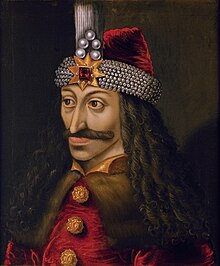Vlad Tepes - Romanian history
While searching I found a website which provides a very detailed history of this historical figure.
Some details for you, which maybe will inspire you to read a bit more in order to realise that my native country, Romania, is not only about vampires and garlic.
To begin with, his castle, Bran.

Vlad Tepes intermittently ruled an area of the Balkans called Wallachia in the mid 15th century, being also called by the names Vlad III, Vlad Dracula and Vlad the Impaler. The word Tepes stands for "impaler" and was so coined because of Vlad’s propensity to punish victims by impaling them on stakes, then displaying them publicly to frighten his enemies and to warn would-be transgressors of his strict moral code.
His portrait:

King Sigismund of Hungary, who became the Holy Roman Emperor in 1410, founded a secret fraternal order of knights called the Order of the Dragon to uphold Christianity and defend the Empire against the Ottoman Turks. Its emblem was a dragon, wings extended, hanging on a cross. Vlad III’s father (Vlad II) was admitted to the Order around 1431 because of his bravery in fighting the Turks. From 1431 onward Vlad II wore the emblem of the order and later, as ruler of Wallachia, his coinage bore the dragon symbol.
The word for dragon in Romanian is "drac" and "ul" is the definitive article. Vlad III’s father thus came to be known as "Vlad Dracul," or "Vlad the dragon." In Romanian the ending "ulea" means "the son of". Under this interpretation, Vlad III thus became Vlad Dracula, or "the son of the dragon." Thus the origin of Dracula.
The scholars make the connection between Vlad Tepes and Barm Stoker's character based on several facts:
The fictional Dracula and the historical Dracula share the same name. There can be no doubt that Bram Stoker based his character upon some reference to Vlad Dracula.
Stoker researched various sources prior to writing the novel, including the Library at Whitby and literature from the British Museum. It is entirely possible that his readings on Balkan history would have included information about Vlad Tepes.
Stoker was the friend of a Hungarian professor from Budapest, named Arminius Vambery, who he met personally on several occasions and who may have given him information about the historical Dracula.
Some of the text of Stoker’s novel provides direct correlations between the fictional Dracula and Vlad Tepes (e.g., the fighting off of the Turks--also, the physical description of Dracula in the novel is very similar to the traditional image of Vlad Tepes.).
Other references in the novel may also be related to the historical Dracula. For example, the driving of a stake through the vampire’s heart may be related to Vlad’s use of impalement.
If you want to find more, just go and read the information on the site, I found it fascinating.
And this what the movie making business made out of this!














